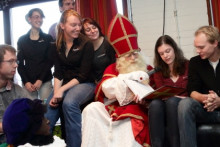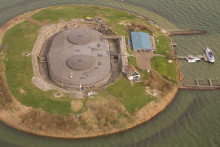What it is?
Sinterklaas is a children´s festival, celebrated in The Netherlands and Belgium on December 5th. Already in November, Sinterklaas comes from Spain in his steamboat called ´Pakjesboot 13 (present boat 13)´ with many helpers, called ´Zwarte Pieten (Black Petes)´. On this boat, they transport many presents for all children who behaved well throughout the year. Once arrived on the mainland, Sinterklaas gets off the boat to ride his white horse.
Every night until December 5th, children put their shoes near the chimney in the house, sing songs and leave behind food for Amerigo, the horse of Sinterklaas. If they are lucky, Sinterklaas will pay a visit and surprise them with presents in their shoes. But the children never see Sinterklaas, as he is on the roof, together with Schimmel and Zwarte Piet. Zwarte Piet is the one to go down the chimney to make sure the right present ends up in the right shoe.
On December 5th, Sinterklaas visits many children in their house. The kids may then thank Sinterklaas and Zwarte Piet, and get a lot of candy and more presents. On December 6th, Sinterklaas returns to Spain.
Is Sinterklaas the Dutch Santa Claus?
Absolutely not. This is the most common misconception about the holiday. Sinterklaas and Santa Claus are two separate persons and are both acknowledged in The Netherlands. Although present-giving during Christmas is becoming increasingly popular, Santa Claus as a personality really cannot compete to Sinterklaas. There are very persistent stories where Santa Claus was based on the image of Sinterklaas, when Coca Cola personified him for marketing purposes. Also the name Santa Claus derived from Sinterklaas´ full name Saint Nicolaas. So if anything, Santa Claus could be considered the American Sinterklaas.
What is the origin of Sinterklaas?
According to the legend, Saint Nicolaas was a bishop who lived in Myra, the present-day Demre in Turkey, around the year 300. As he cared for the poor, it broke his heart to see that a man with three daughters had no money to support them, let alone pay their dowry. His only choice was to send them into prostitution. The story goes that Saint Nicolaas wanted to prevent this, and threw money through the window, accidentally ending up in a shoe.
Sinterklaas has been celebrated for ages, in many different ways. The modern festivities are largely shaped by teacher Jan Schenkman, who wrote a book about it in the 1850s.
Why are the ´Zwarte Pieten´ black?
Although Zwarte Piet was only introduced in 1850, there are two most popular explanations for Pete´s colour.
According to the first story, Saint Nicolaas the bishop of Myra bought an Ethiopian slave and set him free. The second story tells how the ´Pieten´ are black because of soot. After all, they have to go down chimneys to get the presents to the children. The latter version is increasingly being told, especially since the discussion on racism has started to grow.
Is Sinterklaas racist?
There are people who find Sinterklaas a racist celebration, because they find that Zwarte Piet is portrayed as a dumb helper of a white boss. To some groups, this represents slavery or the regard of black people as an inferior race. The discussion has been taking place on an annual basis since the 1960´s, but never really hit ground. Until this year, when even the United Nations decided to establish a taskforce to study whether or not the celebration is racist. Already before the investigation has begun, taskforce leader Verene Shepherd shared her personal opinion that Sinterklaas should be abolished and that ´one Santa Claus´ should be enough. These comments were received with astonishment in The Netherlands, given that this severely provides the impression of a biased investigation, and the fact that Shepherd was clearly not informed about Sinterklaas and Santa Claus as being totally different to each other.
Most Dutch people do not know where the discussion is coming from. To most, Sinterklaas and Zwarte Piet were a magical and care-free part of their childhood, which they would like their children to experience in the same way. Zwarte Piet is an essential part of the story, making the celebration lively and fun. Hardly any child sees Zwarte Piet as something negative, let alone that they make the connection to slavery or seeing non-whites as inferior races. Even adults never made the connection before the discussion started to mount. Surprising detail: In Belgium, where the celebration is identical, the discussion does not take place at all.
What´s next?
Prime minister Rutte stated last week that ´Zwarte Piet is black because of the soot´, that ´Zwarte Piet is black and I can´t help that´, and that it is ´a matter of society, not government´. However, Shepherd´s call to stop Sinterklaas altogether urged a delegation of the government that is currently visiting New York, to take action. They request clarification from Shepherd about her early conclusions.
Sinterklaas will arrive in The Netherlands on 16 November in Groningen. Let´s see who accompanies him.




